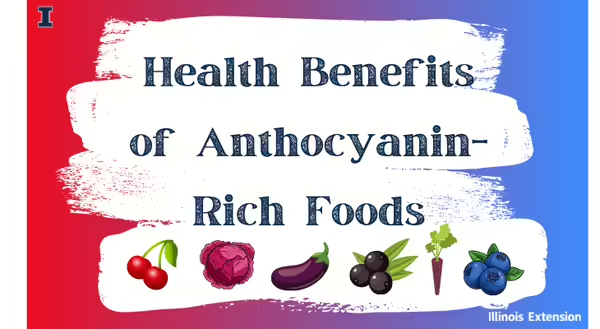
Eat Red, Blue, and Purple Foods for Better Health
The function of Anthocyanins in Plants
- Colored pigments in plants are produced to protect them from pathogens, predators, and climate conditions.
- They attract pollinators and act as antifeedants (adversely affects insects when eaten) and phytoalexins (inhibit the growth of parasites).
- Contribute to the plants’ sensory characteristics, color, and nutritional value.
- Natural colorants used in the food industry.
Dietary Sources of Anthocyanins
Anthocyanins are found in many plant sources including flowers, fruits, and vegetables.
- Fruits- acai, apples, elderberries, chokeberries, blueberries, raspberries, cherries, red and purple grapes, black currants, pomegranates
- Vegetables- red cabbage, purple potatoes, black carrots, eggplant, eggplant, red onions, black beans
- Edible flowers- red hibiscus, red clover, blue cornflower, blue rosemary, purple mint, purple sage, lavender
Increased attention has focused on the health benefits of consuming anthocyanin-rich foods and beverages.
Anti-inflammatory benefits- inflammation can happen in the body for a number of reasons. Perhaps it’s due to a response to stimuli (allergies), injuries, or pathogens. Inflammation results in redness, pain, function losses, and also a large number of pro-inflammatory markers in the body. It’s important to treat inflammation since it is linked to many chronic diseases.
Anthocyanins help to reduce the pro-inflammatory levels in the body and also help facilitate muscle recovery after intense exercise. They protect against diabetes, obesity, have neuroprotective effects, aid in weight management, and improve vision.
Antioxidant benefits- free radicals are a product of the body’s natural metabolism. However, an accumulation can be toxic and lead to the acceleration of the aging process and chronic conditions such as neurodegenerative and cardiovascular disorders, cancer, atherosclerosis, and ulcerative colitis.
Anthocyanins exhibit anti-oxidant capacity and have the ability to reduce the formation of free radicals and protect our cells from damage. Due to their antioxidant capacity, they have also demonstrated the ability to inhibit the initiation and progression of certain cancers such as colon, liver, breast, brain, and skin, among others.
Add More Anthocyanins to your Diet
Intake is higher in countries with a Mediterranean diet. For example, the average intake is 54.5 mg per person/day in Italy whereas in the U.S. it is only 12.5 mg per person/day. Anthocyanins are considered non-essential nutrients so recommended daily intakes are not well established. However, China is recommending a daily intake of 50 mg to help combat the risk of cancer, diabetes, and other degenerative diseases.
The Mediterranean eating pattern is high in fruits, vegetables, whole grains, legumes, and healthy fats. Ensure you’re getting a good daily dose of anthocyanins by eating more of the red, blue, and purple foods listed above. Want to learn more? Check out, Give your meals a Mediterranean makeover
Interested in the bright orange subgroup? Learn more about the health benefits of carotenoid-rich foods- Eat carotenoid-rich foods for better health: University of Illinois Extension
Interested in the green subgroup? Learn more about the health benefits of chlorophyll-rich foods- Eat green foods for better health: University of Illinois Extension
Interested in the white subgroup? Learn more about the health benefits of anthoxanthin-rich foods- Eat white fruits and vegetables for better health: University of Illinois Extension
Sources:
Wu, Xianli, Gary R. Beecher, Joanne M. Holden, David B. Haytowitz, Susan E. Gebhardt, and Ronald L. Prior. 2006. “Concentrations of Anthocyanins in Common Foods in the United States and Estimation of Normal Consumption.” J. Agric. Food Chem. 54. 4069−4075. https://pubs.acs.org/doi/10.1021/jf060300l
Khoo, Hock Eng, Azrina Azlan, Sou Teng Tang, and See Meng Lim. 2017. “Anthocyanidins and Anthocyanins: Colored Pigments As Food, Pharmaceutical Ingredients, and the Potential Health Benefits”. Food & Nutrition Research 61 (August). https://doi.org/10.1080/16546628.2017.1361779
Gonçalves, Ana C., Ana R. Nunes, Amílcar Falcão, Gilberto Alves, and Luís R. Silva. 2021. "Dietary Effects of Anthocyanins in Human Health: A Comprehensive Review" Pharmaceuticals 14, no. 7: 690. https://doi.org/10.3390/ph14070690